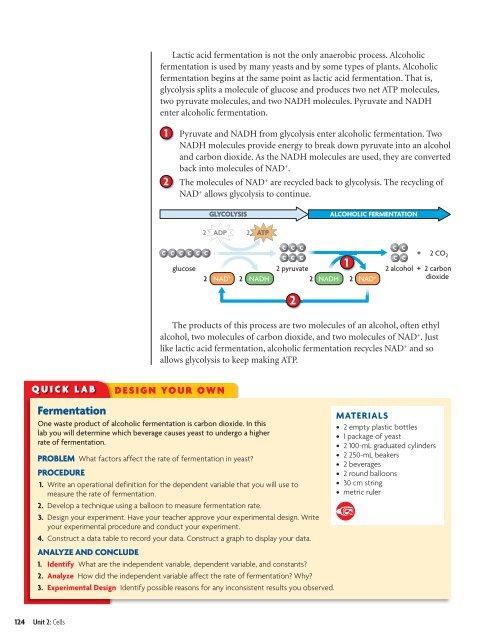Cells and Energy
Cells and Energy
Cells and Energy
Create successful ePaper yourself
Turn your PDF publications into a flip-book with our unique Google optimized e-Paper software.
Lactic acid fermentation is not the only anaerobic process. Alcoholicfermentation is used by many yeasts <strong>and</strong> by some types of plants. Alcoholicfermentation begins at the same point as lactic acid fermentation. That is,glycolysis splits a molecule of glucose <strong>and</strong> produces two net ATP molecules,two pyruvate molecules, <strong>and</strong> two NADH molecules. Pyruvate <strong>and</strong> NADHenter alcoholic fermentation.1 Pyruvate <strong>and</strong> NADH from glycolysis enter alcoholic fermentation. TwoNADH molecules provide energy to break down pyruvate into an alcohol<strong>and</strong> carbon dioxide. As the NADH molecules are used, they are convertedback into molecules of NAD + .2 The molecules of NAD + are recycled back to glycolysis. The recycling ofNAD + allows glycolysis to continue.GLYCOLYSISALCOHOLIC FERMENTATION 1 2The products of this process are two molecules of an alcohol, often ethylalcohol, two molecules of carbon dioxide, <strong>and</strong> two molecules of NAD + . Justlike lactic acid fermentation, alcoholic fermentation recycles NAD + <strong>and</strong> soallows glycolysis to keep making ATP.QUICK LABDESIGN YOUR OWNFermentationOne waste product of alcoholic fermentation is carbon dioxide. In thislab you will determine which beverage causes yeast to undergo a higherrate of fermentation.PROBLEM What factors affect the rate of fermentation in yeast?PROCEDURE1. Write an operational definition for the dependent variable that you will use tomeasure the rate of fermentation.2. Develop a technique using a balloon to measure fermentation rate.3. Design your experiment. Have your teacher approve your experimental design. Writeyour experimental procedure <strong>and</strong> conduct your experiment.4. Construct a data table to record your data. Construct a graph to display your data.ANALYZE AND CONCLUDE1. Identify What are the independent variable, dependent variable, <strong>and</strong> constants?2. Analyze How did the independent variable affect the rate of fermentation? Why?3. Experimental Design Identify possible reasons for any inconsistent results you observed.MATERIALS• 2 empty plastic bottles• 1 package of yeast• 2 100-mL graduated cylinders• 2 250-mL beakers• 2 beverages• 2 round balloons• 30 cm string• metric ruler124 Unit 2: <strong>Cells</strong>
















